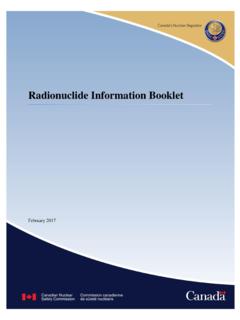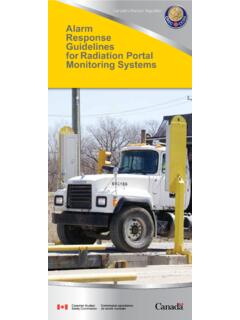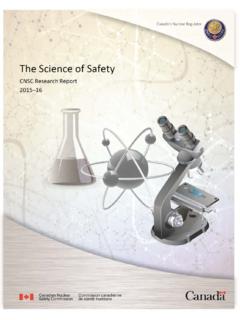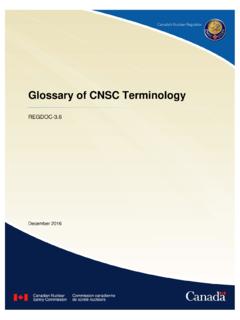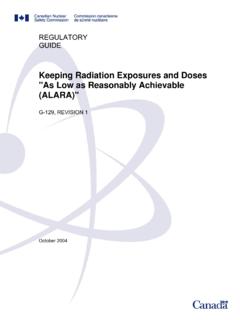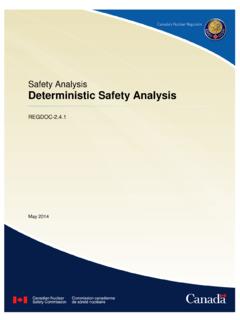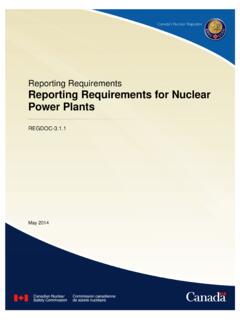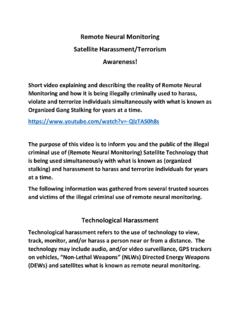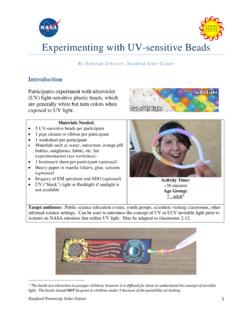Transcription of Introduction to Radiation
1 December 2012 Introduction to Radiation Introduction to Radiation Minister of Public Works and Government Services Canada (PWGSC) 2012 PWGSC catalogue number CC172-93/2012E-PDF ISBN 978-1-100-21572-3 Published by the Canadian Nuclear Safety Commission (CNSC) Extracts from this document may be reproduced for individual use without permission provided the source is fully acknowledged. However, reproduction in whole or in part for purposes of resale or redistribution requires prior written permission from the Canadian Nuclear Safety Commission. galement publi en fran ais sous le titre de : Introduction au rayonnement Document availability This document can be viewed on the CNSC Web site at To order a printed copy of the document in English or French, please contact: Canadian Nuclear Safety Commission 280 Slater Street Box 1046, Station B Ottawa, Ontario K1P 5S9 CANADA Tel.: 613-995-5894 or 1-800-668-5284 (in Canada only) Facsimile: 613-995-5086 Email: Web site: Introduction to Radiation December 2012 December 2012 Table of Contents 1.
2 1 2. Introduction to 2 Atoms: Where all matter begins ..2 3. Types and Sources of Radiation .. 6 Non-ionizing Ionizing Natural sources of ionizing Artificial (man-made) sources of ionizing Striking a 4. health Effects of Radiation Exposure .. 13 Epidemiological Cancer risk assessment ..14 How Radiation affects 5. Radiation Doses .. 18 Absorbed Equivalent Effective dose ..19 Typical Radiation doses ..19 Natural Radiation .. 19 Man-made sources .. 21 Dose 6. Regulating 25 Protecting Canadians ..25 Protecting 7. 29 Acronyms and Units .. 36 36 i December 2012 List of Tables Table 1: Potassium-40 content of certain 10 Table 2: Radioactive isotopes found in the human body (70 kg adult) .. 10 Table 3: Radiation doses, dose limits and potential health effects .. 17 Table 4: Average effective dose in select Canadian cities compared to worldwide average.
3 21 Table 5: Typical equivalent doses from various radiological 22 Table 6: Maximum effective annual doses to members of the public by year, from airborne and waterborne 24 List of Figures Figure 1: The electromagnetic 1 : Model of an atom .. 2 Figure 2 Figure 3: The periodic table of elements .. 3 Figure 4: Radioactive decay curve of carbon-14 .. 5 Figure 5: Penetration abilities of different types of ionizing 7 : Sources of natural 8 Figure 6 Figure 7: A gamma camera used in nuclear medicine, for diagnosing illnesses .. 11 Figure 8: A portable nuclear 11 Figure 9: McClean Lake Uranium Mine (Saskatchewan) .. 12 Figure 10: Models to estimate the health risks from exposure to low levels of ionizing Radiation .. 15 : A strand of DNA .. 16 Figure 11 Figure 12: Relationship between effective, equivalent and absorbed 18 Figure 13: Tissue weighting 19 Figure 14: Annual outdoor effective dose from cosmic Radiation for North America (in microsieverts).
4 20 Figure 15: Doses from natural background Radiation in Canada .. 21 : Radiation dose limitation 23 Figure 16 Figure 17: Canadian occupational dose by facility type for 2007 .. 23 ii December 2012 Introduction to Radiation 1. Overview Radiation is energy in the form of waves or streams of particles. There are many kinds of Radiation all around us. When people hear the word Radiation , they often think of atomic energy, nuclear power and radioactivity, but Radiation has many other forms. Sound and visible light are familiar forms of Radiation ; other types include ultraviolet Radiation (that produces a suntan), infrared Radiation (a form of heat energy), and radio and television signals. Figure 1 presents an overview of the electromagnetic spectrum; section 3 will go into greater detail on the different types of Radiation . Figure 1: The electromagnetic spectrum Reproduced by permission of World Nuclear Association, London, UK.
5 Uncontrolled use of man-made Radiation carries a potential risk to the health and safety of workers and the public. This is where the Canadian Nuclear Safety Commission (CNSC) comes in. The CNSC regulates the use of nuclear energy and materials to protect the health , safety and security of Canadians and the environment from the effects of Radiation . The purpose of this document is to provide clear and simple information about Radiation : what it is, where it comes from and how it is used. It also presents information on Radiation health effects, Radiation doses and how the CNSC ensures the safety of the Canadian nuclear sector through its comprehensive regulatory framework and vigilant oversight. 1 December 2012 2. Introduction to Radiation All life has evolved in an environment filled with Radiation .
6 The forces at work in Radiation are revealed upon examining the structure of atoms. Atoms are a million times thinner than a single strand of human hair, and are composed of even smaller particles some of which are electrically charged. Sections to discuss atoms in more detail, along with basic Radiation -related principles. Atoms: Where all matter begins Atoms form the basic building blocks of all matter. In other words, all matter in the world begins with atoms they are elements like oxygen, hydrogen, and carbon. An atom consists of a nucleus made up of protons and neutrons that are kept together by nuclear forces and electrons that are in orbit around the nucleus (see Figure 2). The nucleus carries a positive charge; protons are positively charged, and neutrons do not carry a charge. The electrons, which carry a negative charge, move around the nucleus in clouds (or shells). The negative electrons are attracted to the positive nucleus because of the electrical force.
7 This is how the atom stays together. Figure 2: Model of an atom Each element is distinguished by the number of protons in its nucleus. This number, which is unique to each element, is called the atomic number . For example, carbon has six protons; therefore, its atomic number is 6 on the periodic table (see Figure 3). In an atom of neutral charge, the atomic number is also equal to the number of electrons. An atom s chemical properties are determined by the number of electrons, which is normally equal to the atomic number. 2 December 2012 Figure 3: The periodic table of elements Atoms from one or more elements combine to form molecules. A molecule of water, for example, is formed of two atoms of hydrogen bound to one atom of oxygen (H2O).
8 A nuclide is a specific type of atom characterized by the number of protons and neutrons in its nucleus, which approximates the mass of the nuclide. The number that is sometimes given with the name of the nuclide is called its mass number (the total number of protons and neutrons in the nucleus). For example, a nuclide of carbon with 6 protons and 6 neutrons is called carbon-12. Isotopes An isotope is a variant of a particular chemical element. While all isotopes of a given element have the same number of protons, each isotope has a different number of neutrons. For example, hydrogen has three isotopes (or variants): hydrogen-1 (contains one proton and no neutrons) hydrogen-2, which is called deuterium (contains one proton and one neutron) hydrogen-3, which is called tritium (contains one proton and two neutrons) Another example is uranium-235, which has 92 protons and 143 neutrons, as opposed to uranium-238, which has 92 protons and 146 neutrons.
9 3 December 2012 An isotope is stable when it has a balanced number of neutrons and protons. In general, when an isotope is small and stable, it contains close to an equal number of protons and neutrons. Isotopes that are larger and stable have slightly more neutrons than protons. Examples of stable nuclides include carbon-12 (six protons and six neutrons for a total mass of 12), phosphorus-30 (15 protons and 15 neutrons) and sodium 22 (11 protons and 11 neutrons). Radioisotopes Isotopes that are not stable and emit Radiation are called radioisotopes. A radioisotope is an isotope of an element that undergoes spontaneous decay and emits Radiation as it decays. During the decay process, it becomes less radioactive over time, eventually becoming stable.
10 Once an atom reaches a stable configuration, it no longer gives off Radiation . For this reason, radioactive sources or sources that spontaneously emit energy in the form of ionizing Radiation as a result of the decay of an unstable atom become weaker with time. As more and more of the source s unstable atoms become stable, less Radiation is produced and the activity of the material decreases over time to zero. The time it takes for a radioisotope to decay to half of its starting activity is called the radiological half-life, which is denoted by the symbol t . Each radioisotope has a unique half-life, and it can range from a fraction of a second to billions of years. For example, iodine-131 has an eight-day half-life, whereas plutonium-239 has a half-life of 24,000 years. A radioisotope with a short half-life is more radioactive than a radioisotope with a long half-life, and therefore will give off more Radiation during a given time period.

